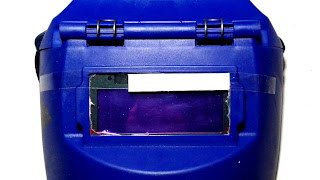Automated welding lenses function by electrically activating a liquid crystal filter inside the lens to darken the lens and shield the welder's face and eyes from ultra violet and infrared radiation. The system absorbs energy from the light from the welding arc. Once the welding is finished, the lens will immediately begin to clear again. The welding mask does not need to be opened or closed.
The automatic lens from the welding mask will darken if the solar cell catches infrared light. To test the lens, it needs a source of infrared light, which can be from the AC remote or TV remote. AC remotes usually have a stronger infrared beam than TV remotes. A sufficiently bright area is needed to test the lens with the remote, so that the solar panel (solar cell) gets enough energy. In the lens there is a liquid crystal which will become dark in color if it is electrified from a solar cell.
Liquid crystal circuits are commonly used in digital displays (screens) on multimeters, calculators, speedometers, wall clocks, and other instruments. Usually, in these digital measuring instruments, liquid crystal will form black numbers and letters if it is electrified.
In the photo above, you can see two rows of solar cells at the top of the lens, as shown with a finger. The following YouTube video shows how to test an auto lens with an AC remote and a TV remote.
Simple and inexpensive auto-dark welding mask lenses are usually not equipped with a lens shade adjustment level. So if the welding process is carried out in a dark place, it will be difficult to see the object being welded because the lens is too dark. Actually, if the working area is dark, you have to use a spotlight to brighten the workpiece being welded. But sometimes spotlights are not available.
It is possible to compensate for a too-dark welding lens by partially covering the solar cells on the welding lens. Solar cells are covered with white cardboard glued to clear tape, as shown in the photo below.
Both tape ends stick to the side of the welding cover, not to the solar cell. Avoid sticking the tape directly on the solar cell, because there will be residual glue from the tape sticking and contaminating the solar cell. The more area of the solar cell that is covered with paper, the brighter the lens (less dark) when welding.
This method is not recommended because the amount of lens darkening is not measured to determine whether or not it is safe. The only indicator is the level of eye comfort: can the workpiece be seen clearly, or is the welding light too bright and the lens should be darker? However, if no other options are available, this method of closing solar cells is adequate.


No comments:
Post a Comment
Your positive comment will be highly appreciated to improve this site